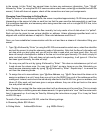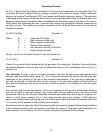21
Operating Principle
All M or V Series Gas Flow Meters are based on the accurate measurement of volumetric ow. The
volumetric ow rate is determined by creating a pressure drop across a unique internal restriction,
known as a Laminar Flow Element (LFE), and measuring differential pressure across it. The restriction
is designed so that the gas molecules are forced to move in parallel paths along the entire length of the
passage; hence laminar (streamline) ow is established for the entire range of operation of the device.
Unlike other ow measuring devices, in laminar ow meters the relationship between pressure drop
and ow is linear. The underlying principle of operation of the 16 Series ow meters is known as the
Poiseuille Equation:
Q = (P
1
-P
2
)�r
4
/8ηL (Equation 1)
Where: Q = Volumetric Flow Rate
P
1
= Static pressure at the inlet
P
2
= Static pressure at the outlet
r = Radius of the restriction
η = (eta) absolute viscosity of the uid
L = Length of the restriction
Since �, r and L are constant; Equation 1 can be rewritten as:
Q = K (∆P/η) (Equation 2)
Where K is a constant factor determined by the geometry of the restriction. Equation 2 shows the linear
relationship between volumetric ow rate (Q) differential pressure (∆P) and absolute viscosity (η) in a
simpler form.
Gas Viscosity: In order to get an accurate volumetric ow rate, the gas being measured must be
selected (see Gas Select Mode, page 12). This is important because the device calculates the ow
ratebased on the viscosity of the gas at the measured temperature. If the gas being measured is
not what is selected, an incorrect value for the viscosity of the gas will be used in the calculation of
ow, and the resulting output will be inaccurate in direct proportion to the difference in the two gases
viscosities.
Gas viscosity, and thus gas composition, can be very important to the accuracy of the meter. Anything
that has an effect on the gas viscosity (e.g. water vapor, odorant additives, etc.) will have a direct
proportional effect on the accuracy. Selecting methane and measuring natural gas for instance, will
result in a fairly decent reading, but it is not highly accurate (errors are typically < 0.6%) because
natural gas contains small and varying amounts of other gases such as butane and propane that result
in a viscosity that is somewhat different than pure methane.
Absolute viscosity changes very little with pressure (within the operating ranges of these meters) therefore
a true volumetric reading does not require a correction for pressure. Changes in gas temperature do
affect viscosity. For this reason, the M or V Series internally compensate for this change.


















